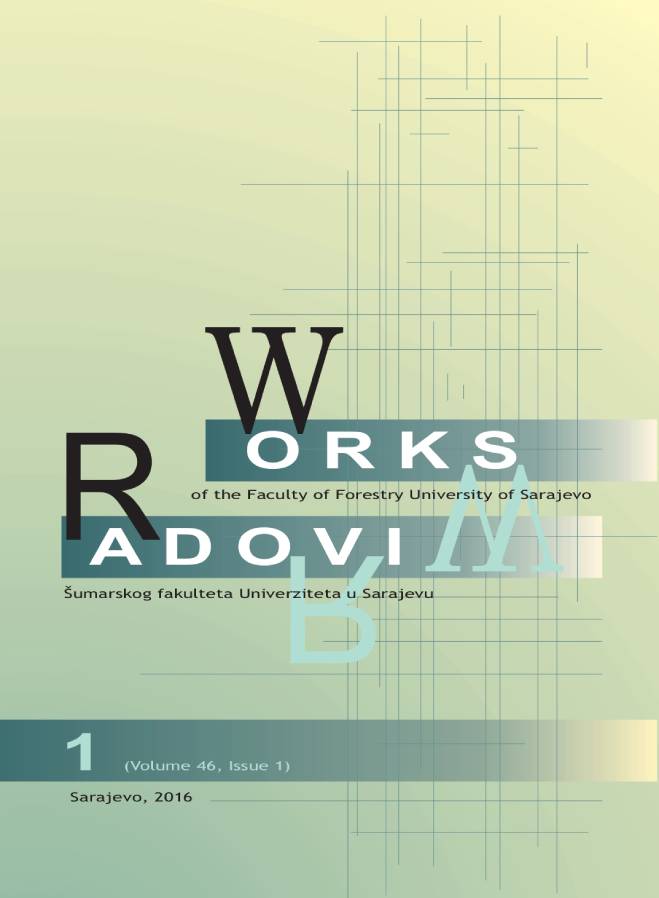DAMAGE ON STANDING TREES DURING WOOD SKIDDING (WINCHING PHASE) BY CABLE SKIDDER TIMBERJACK 225 A
DOI:
https://doi.org/10.54652/rsf.2016.v46.i1.80Keywords:
forest harvesting, wood skidding, tree damageAbstract
UDK: 630*37:630*4
Hauling of heavy and voluminous load (wood) partially through forest wastelands and partially on built roads makes this the most expensive phase, which is also technically the most challenging and most damaging for the forest eco-system. Although it is clear that the realisation of this phase in forest harvesting cannot be completed without certain forest damage, in expert and scientific circles there is general consent that by careful planning and execution in forestry, this damage can be brought down to an ‘acceptable’ level.
One of the reliable indicators of stand damage is the amount of mechanical damage resulting from forest harvesting operations. This damage can be ascertained rather easily and correctly, and the environmental and economic consequences of mechanical damage of standing trees are better known than those resulting from damaging saplings or the soil. (Martinić, 2000). Pertaining to this, this paper presents the measuring and analysis of mechanical damage to standing trees as a result of hauling trees using the cable skidder ‘Timberjack 225 A’ in the forest unit 17, Management Unit ‘Gornja Stavnja’, Forest Management Company ‘Gornjebosansko’. The amount of damage was analysed, the place where it occurred on the tree, the level of damage and the surface of the inflicted damage. All the stated analyses were carried out for two ways of skidding wood using a winch (falling and ascending).
Results show, among others, that the stand damage expressed in the percentage of damaged trees of the total tree count is 15.41%, which is the upper limit Martinić (1993) ascertained for this phase of forest harvesting, including the variability of working methods and techniques. Almost half of the damage is stated in the first third of the distance between the skidder path and transport boundary, with the largest amount of damage occurring on the most valuable part of the tree (butt end), especially during slope skidding.
Downloads
References
ATHANASSIADIS, D. (1997): Residual stand damage following cut-to-length harvesting operations with a farm tractor in two conifer stands. Silva Fennica 31(4): 461- 467.
GLAZAR, K. AND MACIEJEWSKA, M. (2009): Ecological aspect of wood harvesting amd skidding in pine stands with use different technologies. Acta Sci. Pol. Silv. Colendar. Rat. Ind. Lignar. 8(3), pp. 5-14.
DANILOVIĆ M., KOSOVSKI M., GAČIĆ D., STOJNIĆ D., ANTONIĆ S. (2015). Damage to residual trees and regeneration during felling and timber extraction in mixed and pure beech stand. Šumarski list. 5-6:253-262.
ISOMAKİ, A. AND KALLİO, T. (1974): Consequences of injury caused by timber harvesting machines on the growth and decay of spruce (Picea abies (L) Karst.) Acta For. Fenn. 136, 1-25.
KRIŠTO, R. ( 2012): Analiza oštećenja sastojine koja nastaju pri primicanju i privlačenju drveta. Diplomski rad. Šumarski fakultet u Sarajevu.
KRPAN, A. P. B., PETREŠ, S., IVANOVIĆ, Ž: (1993): Neke fizičke štete u sastojini, posljedice i zaštita (Forest stand damage,effects and protection). Glasnik za šumske pokuse, Posebno izdanje, 4: 271–279.
KULUŠIĆ, B. (2000): Manuskript - Iskorišćavanje šuma. Šumarski fakultet u Sarajevu.
LIMBECK–LILIENAU, B. (2003): Residual stand damage caused by mechanized harvesting systems. In: Proceedings of the Austro2003 meeting: High Tech Forest Operations for Mountainous Terrain. CD ROM. Limbeck-Lilienau, Steinmüller and Stampfer (editors). October 5-9, 2003, Schlaegl – Austria. 11 p.
LOJO, A. I MUSIĆ, J. (2006): Vrste i brojnost oštećenja stabala jele (Abies alba Mill.) u šumama bukve i jele sa smrčom. III Simpozijum o zaštiti bilja u BiH. Neum, 13.-15. decembar 2006. Zbornik rezimea, str. 52-53.
MATIĆ, V., DRINIĆ, P., STEFANOVIĆ,V., ĆIRIĆ, M. I SARADNICI (1971): Stanje šuma u Bosni i Hercegovini prema inventuri šuma na velikim površinama u 1964-1968. godini. Šumarski fakultet i Institut za šumarstvo. Posebna izdanja, broj 7. Sarajevo.
MATIĆ, S. (1983): Šuma i mehanizacija. Zbornik savjetovanja "Šumarska mehanizacija u teoriji i praksi" Opatija, 1983, str. 37-46.
MARTINIĆ, I. (1993): Neke činjenice u svezi sa šumskim radovima. Glas. šum. pokuse, posebno izdanje 4, 321-330.
MARTINIĆ, I. (2000): Koliko smo blizu ekološki prihvatljivoj uporabi mehanizacije u šumarstvu? Šumarski list br. 1-2, CXXIV, str. 3-13.
MENG, W., (1978): Baumverletzungen durch Transportvorgänge bei der Holzernte – Ausmaß und Verteilung, Folgeschäden am Holz und Versuch ihrer Bewertung. Schriftenreihe der LFV Baden-Württemberg, Band 53, 159 str.
PIČMAN, D., PENTEK, T., PORŠINSKY, T. (2003): Prilog istraživanju oštećivanja stabala mehanizacijom za gradnju šumskih putova. Strojarstvo 45(4–6): 149–157.
PORŠINSKY, T., OŽURA, M. (2006): Oštećivanje dubećih stabala pri izvoženju drva forvarderom. Nova mehanizacija šumarstva. Vol. 27., str. 41-49.
REISINGER, T.W. AND POPE, P.E. (1991): Impact of timber harvesting on residual trees in a central hardwood forest in Indiana. Proceedings 8th Central Hardwood Forest Conference. University Park, Pennsylvania. March 4-6, 1991.
SABO, A. (2003): Oštećivanje stabala pri privlačenju drva zglobnim traktorom TIMBERJACK 240C u prebornim sastojinama. Šumarski list 7 -8, str. 335-348.
SIRÉN, M. (2001): Tree Damage in Single-Grip Harvester Thinning Operations. Journal of Forest Engineering. Vol 12, No. 1, 29-38.
TOMANIĆ, S., VONDRA, V., MARTINIĆ, I. (1989): Oštećivanje sastojine pri šumskim radovima. Mehanizacija šumarstva, 14, br. 3 - 4, 65-72, Zagreb.
VANDERBERG, M. R. (2002): Harvested log damage and value loss associated with two ground-based harvesting system in Central Appalachia. Master thesis. Davis College of Agriculture, Forestry, and Consumer Sciences at West Virginia University.
VASİLİAUSKAS R. (2001): Damage to trees due to forestry operations and its pathological significance in temperate forest: a literature review. Forestry, 74: 319–336.
VESELINOVIĆ, T. (2012): Mehanička oštećenja dubećih stabala i podmlatka kao posljedica radnih operacija iskorišćavanja šuma na području ŠGP „Igmansko". Završni rad. Šumarski fakultet u Sarajevu.






















